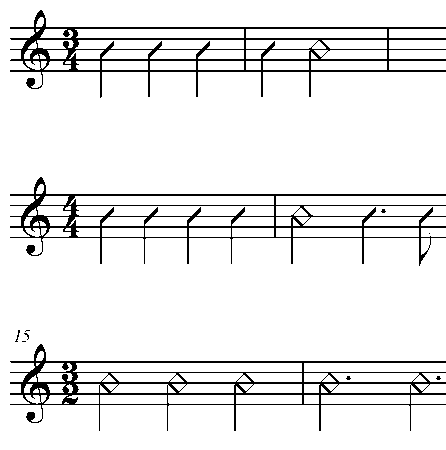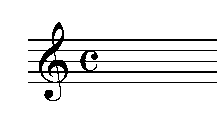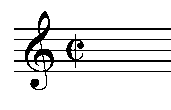Reading Time Signatures
At the beginning of pieces of music we find the Time Signatures. This tells us the meter. Meter is the rhythmic form or structure to a song. The form is repeated in every measure so you could say that each measure is one cycle of the meter. So if the song is in a meter of 3, then the beats would be counted as 1, 2, 3, 1, 2, 3... with each new measure starting on 1.

A time signature is made up of 2 parts. The top number designates how many beats there are in each measure and the bottom number designates what kind of note each beat is. We'll start with the top number because it is easier to understand.
If we have a signatre of 3/4, that means that there will be 3 beats per measure. If we have a signature of 4/4, there will be 4 beats per measure. This doesn't mean that there are only 4 notes in the measure, just a total of 4 beats.
Now for the bottom number. If we have a signature of 3/4 then each beat will be represented as a quarter note. If it is 3/2, then each beat will be represented as half note. Now this doesn't mean that all of the notes in the measure will be half notes. This simply means that all of the notes in the measure have to add up to the total value of 3 half notes. Here are some examples below.

The most used signatures are 2/4, 3/4, 4/4, and 2/2. 4/4 is the most common, so we call it "common time" and it sometimes looks like this:

2/2 is the same thing cut in half so we call it "cut time" and it sometimes looks like this:

The time sigs. we have looked at here are called Basic time sigs. These are the easiest to read and count. When there is an 8 on the bottom, these become complex time signatures, and we will talk about them in a later lesson.
Very Important!
Don't get too worried about these. Some people try to figure out every single one possible and try to understand them intimately. They aren't THAT important. They simply tell you the meter of the song. That is all. They are not some cosmo-magical being that rules the universe of music.
To be quite honest, if you know basically how one works, and you can tell "Okay, there are 3 beats and each beat is a quarter note, so there should be a total value of 3 quarter notes, and the song will have a meter of 1, 2, 3, 1 2, 3," then you can already play music just as well as that guy that knows them to the finest degree.
If in doubt, re-read the title of this website: Music Theory for Musicians, not Theorists. If you want to be a theorist, there are textbooks that can explain more about these, but this should give you enough information to play most music out there.
Return from Reading: Time Signatures to Reading Music
Return from Reading: Time Signatures to Homepage
Hope this helps! Practice hard and let me know if you have any questions!